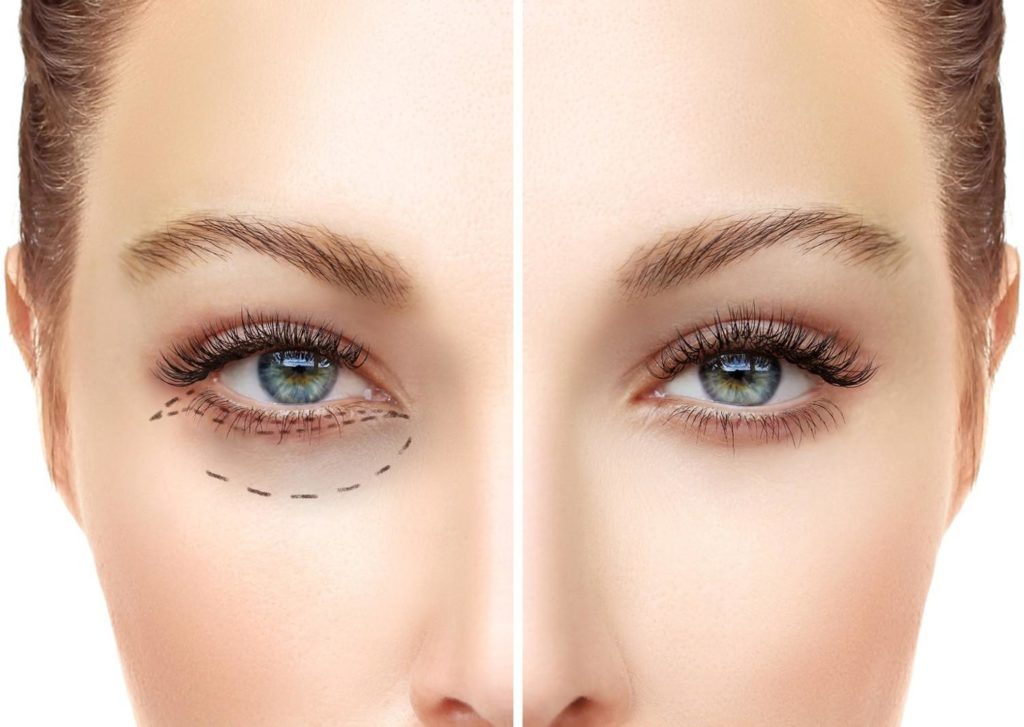Eyelid surgery. It’s a complicated area, so we’re looking at two of the most common procedures here, namely upper and lower blepharoplasty.
The eye area is one of the first to show signs of aging, as the skin around the eyes is so thin. Eyelid surgery is very complex, but the overall aim is usually to restore a youthful appearance to the area through the removal of excess skin, bags, etc. Excess sagging in the eye area can also impact on vision, so sometimes people undergo the procedure for practical reasons.

The eye area is a complicated one to treat. Peri-orbital aging is very complex. There are many factors involved, including photo-aging, loss of skin elasticity, a weakening of muscle and and a loss of movement or volume in the eye area.
As we age, our eyelids stretch, and the muscles that support them begin to weaken. This can result in excess fat gathering above and below the eyes, causing sagging, drooping upper lids and puffy under-eye bags.
Blepharoplasty tends to address the three main components of skin, muscle and fat. The treatment may involve one or all three of these. Often, it is not what you remove but actually what you leave behind that counts, and the final outcome should be tailored to fit the patient’s facial profile so as to blend well with their facial proportions.
Upper blepharoplasty is used to preserve the volume of the upper eyelid folds. Lower blepharoplasty is a more complex and challenging procedure. If too much of the three fat compartments are removed, the eyes can look hollow and even more aged.
You can find out about blepharoplasty and peri-orbital surgery, with the medical terms explained, here.
As with most procedures, the key to successful eyelid surgery lies in the hands of a skilled surgeon. Precision and careful execution of peri-orbital surgery is mandatory, as there is little margin for error.
The consultation procedure should be comprehensive and the patient should understand what is involved and what sort of results they can expect. This is why it is important to know all of the considerations involved in deciding on having a cosmetic procedure done.
Blepharoplasty is a very customised procedure, working on each patient’s own issues and physical features.
The surgery on the upper lid involves a small incision and the removal of excess fat, muscle and skin. During surgery on the lower lid, the surgical incision can be placed at the eyelash margin or through the conjunctiva (transconjunctival approach). In general, a cut is made under the lashes, and excess fat, muscle and skin are removed. Some patients may also require fat injections or a small amount of filler to treat hollowness in the area.

The procedure is usually done on an out-patient basis (day case surgery). There may be temporary issues with vision after the surgery, along with some puffiness and bruising. The surgeon will advise on an after-care regime, which usually involves things like gently cleansing the eye area, the application of cooling eye masks to reduce swelling, avoiding any strain or strenuous exercise for a time, not wearing contacts for two weeks and being very gentle with the eye area.
Surgical rejuvenation of the eyelids can have a significant effect on the appearance of the area, and the whole face as a result.
If you are considering a cosmetic surgery procedure, we can advise on the best options for you. Contact us to arrange a free consultation.
Find out all you need to know about cosmetic surgery procedures and the factors you need to consider in our free guide: Considerations Before Deciding on Cosmetic Surgery and Post- Treatment Care:
Download Mr. Chan's Guide to Cosmetic Surgery Considerations
Eyelid surgery. It’s a complicated area, so we’re looking at two of the most common procedures here, namely upper and lower blepharoplasty.
The eye area is one of the first to show signs of aging, as the skin around the eyes is so thin. Eyelid surgery is very complex, but the overall aim is usually to restore a youthful appearance to the area through the removal of excess skin, bags, etc. Excess sagging in the eye area can also impact on vision, so sometimes people undergo the procedure for practical reasons.

The eye area is a complicated one to treat. Peri-orbital aging is very complex. There are many factors involved, including photo-aging, loss of skin elasticity, a weakening of muscle and and a loss of movement or volume in the eye area.
As we age, our eyelids stretch, and the muscles that support them begin to weaken. This can result in excess fat gathering above and below the eyes, causing sagging, drooping upper lids and puffy under-eye bags.
Blepharoplasty tends to address the three main components of skin, muscle and fat. The treatment may involve one or all three of these. Often, it is not what you remove but actually what you leave behind that counts, and the final outcome should be tailored to fit the patient’s facial profile so as to blend well with their facial proportions.
Upper blepharoplasty is used to preserve the volume of the upper eyelid folds. Lower blepharoplasty is a more complex and challenging procedure. If too much of the three fat compartments are removed, the eyes can look hollow and even more aged.
You can find out about blepharoplasty and peri-orbital surgery, with the medical terms explained, here.
As with most procedures, the key to successful eyelid surgery lies in the hands of a skilled surgeon. Precision and careful execution of peri-orbital surgery is mandatory, as there is little margin for error.
The consultation procedure should be comprehensive and the patient should understand what is involved and what sort of results they can expect. This is why it is important to know all of the considerations involved in deciding on having a cosmetic procedure done.
Blepharoplasty is a very customised procedure, working on each patient’s own issues and physical features.
The surgery on the upper lid involves a small incision and the removal of excess fat, muscle and skin. During surgery on the lower lid, the surgical incision can be placed at the eyelash margin or through the conjunctiva (transconjunctival approach). In general, a cut is made under the lashes, and excess fat, muscle and skin are removed. Some patients may also require fat injections or a small amount of filler to treat hollowness in the area.

The procedure is usually done on an out-patient basis (day case surgery). There may be temporary issues with vision after the surgery, along with some puffiness and bruising. The surgeon will advise on an after-care regime, which usually involves things like gently cleansing the eye area, the application of cooling eye masks to reduce swelling, avoiding any strain or strenuous exercise for a time, not wearing contacts for two weeks and being very gentle with the eye area.
Surgical rejuvenation of the eyelids can have a significant effect on the appearance of the area, and the whole face as a result.
If you are considering a cosmetic surgery procedure, we can advise on the best options for you. Contact us to arrange a free consultation.
Find out all you need to know about cosmetic surgery procedures and the factors you need to consider in our free guide: Considerations Before Deciding on Cosmetic Surgery and Post- Treatment Care:
Download Mr. Chan's Guide to Cosmetic Surgery Considerations